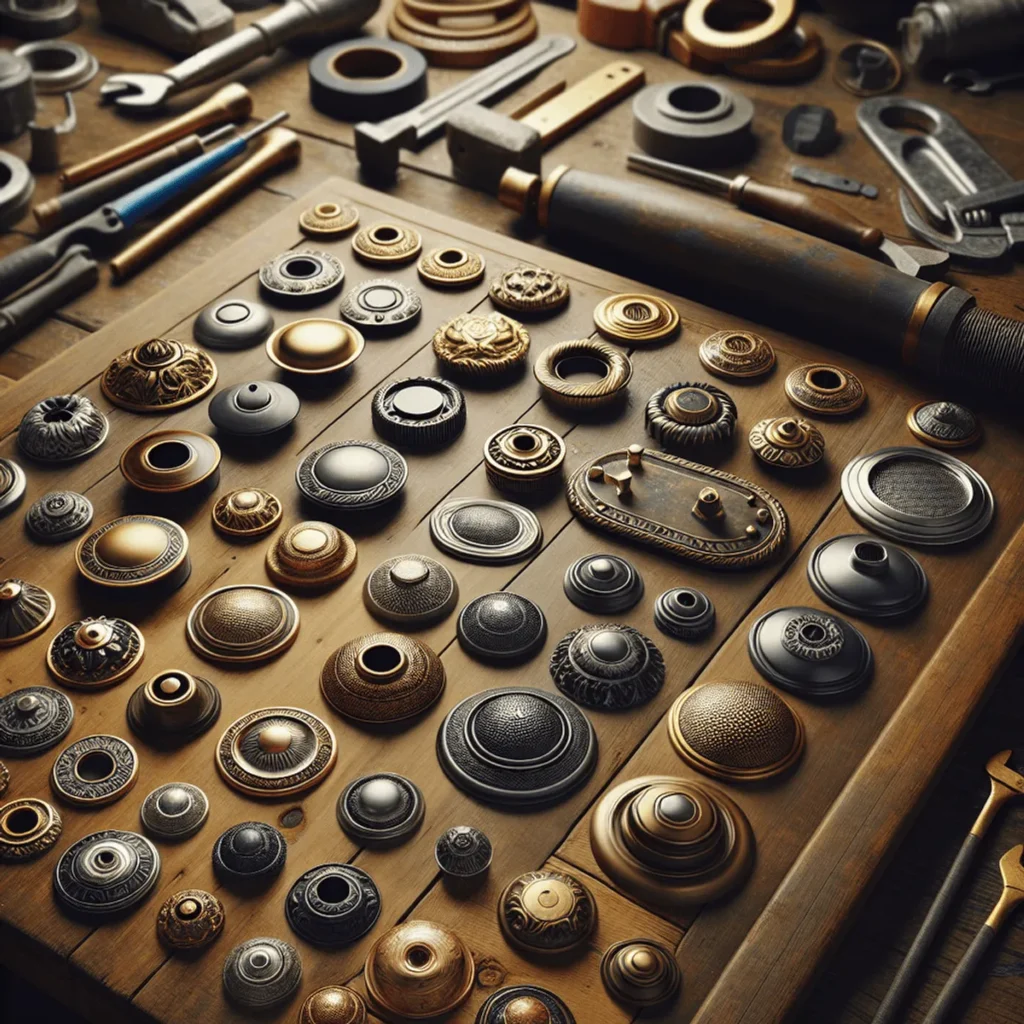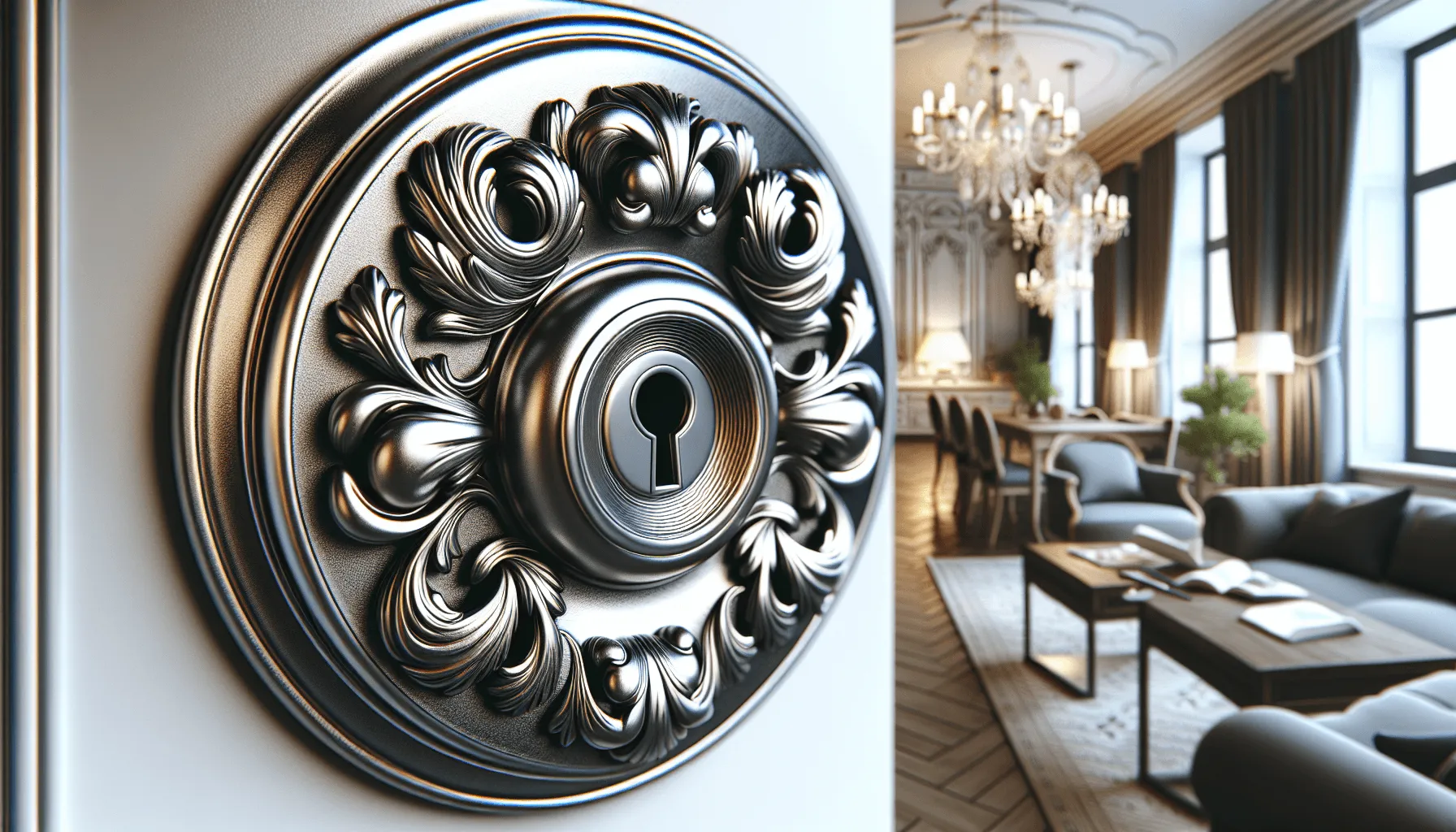Ever noticed the neat, circular plates around pipes or door locks? Those are called escutcheons. An escutcheon is a decorative plate or shield used to cover and conceal gaps around functional items such as pipes, locks, or keyholes. Originating from the Old Norman word meaning “shield,” escutcheons play a crucial role in both plumbing and architecture.
In plumbing systems, escutcheons hide unsightly gaps where pipes penetrate walls or ceilings, offering a polished look while also serving practical purposes. In architectural contexts, they enhance security by covering keyholes and protecting against wear.
This article provides a comprehensive understanding of escutcheons. You will learn about their types, functions, installation processes, and cost considerations. Whether you’re a DIY enthusiast or just curious about home improvement details, you’ll find valuable insights here.
Understanding Escutcheons: A Comprehensive Guide
An escutcheon is a decorative or protective plate that covers gaps around functional items like pipes, locks, or keyholes. It connects the object it surrounds with the surface it goes through, providing a neat appearance and extra protection. In specific applications such as fire sprinklers, understanding the role of escutcheons becomes crucial. What are escutcheons and are they required for fire sprinklers?
Different Styles of Escutcheons
1. Recessed Escutcheons
- Fit flush with surfaces for a seamless appearance.
- Ideal for applications requiring minimal protrusion.
2. Flat Escutcheons
- Designed to accommodate varying distances from pipes to walls.
- Versatile and straightforward in design.
3. Adjustable Escutcheons
- Offer flexibility in installation depth.
- Suitable for scenarios where precise fitting is crucial.
Common Materials Used for Escutcheons

Metal
Pros: Durable, long-lasting, resistant to wear and corrosion.
Cons: Can be more expensive, and heavier than other materials.
Plastic
Pros: Cost-effective, lightweight, and easy to install.
Cons: Less durable, may discolor over time.
Understanding the various types of escutcheons and their materials helps you make informed decisions when selecting the right one for your needs. This knowledge ensures that your installations not only look good but also perform effectively. For instance, if you’re looking for specific options related to fire sprinkler escutcheons, you might want to explore which fire sprinkler escutcheon you need. Additionally, if you need fire sprinkler escutcheon manufacturers, this knowledge will also serve you well.
Escutcheons in Plumbing Systems
An escutcheon in plumbing is an important component that hides gaps around pipes or fixtures, ensuring both a neat appearance and proper functionality. These plates are crucial for covering unattractive holes where pipes go through walls, floors, or ceilings.
Key Applications:
- Faucets: An escutcheon around a faucet provides a clean finish by hiding the hole where the faucet mounts to the sink or countertop.
- Shower Arms: For shower systems, escutcheons cover the opening where the shower arm extends from the wall, preventing moisture infiltration and enhancing aesthetics.
- Shutoff Valves: In areas where shutoff valves protrude from walls or cabinets, an escutcheon conceals the rough cutout, offering a neat and professional look.
Benefits:
- Aesthetic Appeal:
- Conceals gaps and holes
- Provides a finished look
- Functional Protection:
- Prevents debris from entering wall cavities
- Reduces moisture penetration risks
Materials:
Typically made from metal (brass, stainless steel) or plastic, each material has its pros and cons:
- Metal: Durable and visually appealing but often more expensive.
- Plastic: Cost-effective and easy to install but less durable over time.
Using escutcheons in plumbing systems not only makes installations look better but also helps them last longer and work better.
Types of Escutcheons Used in Plumbing Applications

In plumbing, you’ll come across different types of escutcheons, each with its purpose and style. Here are the main types:
Trim Plates
Trim plates, also known as decorative pieces, give a neat look by hiding gaps around plumbing fixtures like faucets and shower arms. They come in various shapes and finishes to match your bathroom or kitchen design.
Flanges
Flanges are sturdier than trim plates and have a dual function. They not only cover the gap but also provide extra support for pipes going through walls or floors. You’ll often find them in situations where strength is important.
Cover Plates
Cover plates, sometimes called blank escutcheons, hide unused pipe openings or holes in walls. They create a smooth, finished look and can be easily installed without any special tools.
Knowing what an escutcheon is helps you choose the right one for your plumbing needs. Whether it’s a trim plate for looks, a flange for support, or a cover plate for practicality, each type has its specific use case.
The Functionality of Escutcheons: Aesthetic vs. Functional Purposes
An escutcheon has two main purposes: to look good and to work well. In plumbing systems, escutcheons serve to conceal gaps around pipes and fixtures, providing a polished appearance. This transforms what would otherwise be unsightly holes into visually appealing components.
Fire Sprinkler Systems:
- Activation and Safety: Escutcheons in fire sprinkler systems are crucial for proper activation. By covering gaps around sprinkler heads, they help maintain the correct pressure and positioning needed for effective operation during a fire.
- Sealing Gaps: They prevent drafts and debris from entering the space around the sprinkler head, ensuring it functions as intended.
- Additionally, it’s important to note that the installation and functionality of these systems must adhere to certain regulations, such as those outlined in the International Building Code, which governs fire protection and life safety systems.
DIY Plumbing Tips:
- When installing or replacing an escutcheon, ensure it fits snugly around the pipe or fixture to avoid potential leaks or gaps.
- Avoid painting escutcheons, as factory finishes are designed to endure environmental wear without additional coatings.
By combining practicality with good looks, escutcheons are essential in both plumbing and fire safety situations.
Installing and Removing Escutcheons: Step-by-Step Guide
How to Install an Escutcheon
Installing an escutcheon plate requires attention to detail. Here’s a step-by-step guide to help you navigate the process:
1. Gather Your Tools
- Escutcheon plate
- Pipe or faucet
- Screwdriver
- Plumber’s putty (optional)
- Measuring tape
2. Prepare the Area
- Ensure the surface around the pipe or faucet is clean.
- Measure the area to ensure the escutcheon fits properly.
3. Position the Escutcheon
- Slide the escutcheon over the pipe or faucet.
- Align it with the wall or surface it will rest against.
4. Secure the Plate
- If using screws, align holes in the escutcheon with pre-drilled holes in the wall and secure with a screwdriver.
- For snug fits, apply the plumber’s putty around the base before positioning for added stability.
5. Check Alignment
Ensure the escutcheon sits flush against the wall without gaps.
Tips for Safely Removing an Old or Damaged Escutcheon
Removing an old escutcheon can be tricky but manageable with some care:
1. Turn Off Water Supply
Always shut off the water to prevent leaks.
2. Loosen Fasteners
- Locate any screws or fasteners securing the escutcheon.
- Use a screwdriver to remove them carefully.
3. Gentle Pry If Necessary
If no fasteners are present, gently pry around the edges using a flathead screwdriver or similar tool.
4. Clean Surface
Once removed, clean any residue from the wall to prepare for a new installation.
Understanding what is an escutcheon plate and how to install an escutcheon ensures both aesthetic appeal and functionality in your plumbing setup. Whether you’re installing a new piece or replacing an old one, these steps provide clarity and ease in managing your fixtures.
Replacing Damaged Escutcheons: Signs and Where to Buy Them
Recognizing when to replace an escutcheon is essential for maintaining the aesthetic and functional aspects of your plumbing systems.
Signs That Indicate When to Replace an Escutcheon
- Visible Rust or Corrosion: Metal escutcheons, especially those exposed to moisture, can develop rust over time.
- Cracks or Breaks: Physical damage like cracks or breaks can compromise the escutcheon’s ability to conceal gaps effectively.
- Discoloration: Discolored or tarnished escutcheons can detract from the overall appearance of your fixtures.
- Loose Fit: An escutcheon that no longer fits snugly around the pipe or fixture needs replacement.
Where to Buy Replacement Escutcheons
Finding the right place to buy replacement escutcheons depends on your specific needs and preferences.
- Plumbing Supply Stores: Often carry a wide selection of specialized escutcheons, providing options in various materials and finishes.
- Hardware Stores: Offer a range of standard escutcheons suitable for most home plumbing applications. These stores are convenient for quick replacements.
- Online Retailers: Websites like Amazon and specialized plumbing websites provide extensive options and customer reviews, making it easier to find exactly what you need.
Investing in a quality replacement ensures longevity and maintains the overall look of your plumbing fixtures.
Escutcheons Beyond Plumbing: Architectural Applications and Benefits
An escutcheon in architectural contexts often refers to a protective or decorative plate used around door locks and keyholes. These plates serve several important purposes:
- Security: Escutcheons help prevent tampering by concealing keyholes and locks, making it more difficult for unauthorized access.
- Wear Protection: By covering the area around locks, escutcheons protect doors from wear and tear due to frequent use.
- Aesthetic Appeal: Available in various designs and finishes, they enhance the visual appeal of doors, adding a touch of elegance or matching existing hardware.
Escutcheons are not limited to doors. They can be found around light switches, electrical outlets, and other fixtures requiring both protection and decorative enhancement. Their dual function in both plumbing and architecture makes them indispensable for maintaining both the functionality and appearance of different structures. Additionally, in the realm of historical architecture, escutcheons play a significant role, often reflecting the design aesthetics of the period they belong to.
Cost Considerations for Escutcheons: Factors Influencing Prices and Average Costs
When evaluating the cost of escutcheon plates, several factors come into play:
- Material Quality: Escutcheons made from premium materials like stainless steel or brass typically cost more than those made of plastic or lower-grade metals.
- Design Complexity: Simple, flat escutcheons are generally less expensive compared to decorative or adjustable models that offer more intricate designs and features.
Average costs can vary widely depending on these factors. For basic plastic escutcheons, you might spend around $2 to $5 each. Metal versions, especially those with high-end finishes, can range from $10 to $50 per piece. Installation costs also vary, often influenced by labor rates and the complexity of the job. DIY installation usually involves minimal expense beyond the purchase price, while professional installation could add $50 to $100 per hour to your budget.
Conclusion: Embracing the Versatility of Escutcheons in Plumbing and Architecture
Escutcheons are incredibly versatile and important in both plumbing and architecture. They play a crucial role in making things work smoothly and look great. Whether you’re working with faucets, shower arms, door locks, or fire sprinkler systems, an escutcheon adds a polished touch while hiding any gaps.
If you ever find yourself struggling with installation or repairs, it’s always a smart move to seek professional help. If you need reliable plumbing assistance, don’t hesitate to reach out to experts like Columbus Plumbers who can ensure your projects are completed efficiently.
Knowing what an escutcheon is and how it can be used in different situations can greatly improve the look and safety of your installations.
FAQs (Frequently Asked Questions)
What is an escutcheon?
An escutcheon is a protective or decorative plate that covers gaps around pipes, fixtures, or other elements in plumbing and architecture. It serves both aesthetic and functional purposes by concealing unsightly areas and providing a finished look.
What are the different types of escutcheons?
Escutcheons come in various styles, including recessed, flat, and adjustable designs. Each type serves specific applications, such as fitting around pipes or fixtures to enhance appearance and functionality.
How do I install an escutcheon?
To install an escutcheon, first position it around the pipe or fixture where it will be mounted. Secure it in place using screws or adhesive, depending on the design. Ensure it fits snugly to cover any gaps for a clean look.
When should I replace my escutcheon?
You should consider replacing your escutcheon if you notice signs of damage such as cracks, or corrosion, or if it no longer fits properly due to changes in plumbing fixtures. Regular inspection can help maintain both function and appearance.
Where can I buy replacement escutcheons?
Replacement escutcheons are typically found at plumbing supply stores, hardware stores, or online retailers. It’s important to choose the right size and style that matches your existing fixtures.
What is the significance of escutcheons in fire sprinkler systems?
Escutcheons play a crucial role in fire sprinkler systems by covering the gap between the sprinkler head and the ceiling. They not only enhance aesthetics but also ensure proper activation of the system during emergencies.


Comments are closed